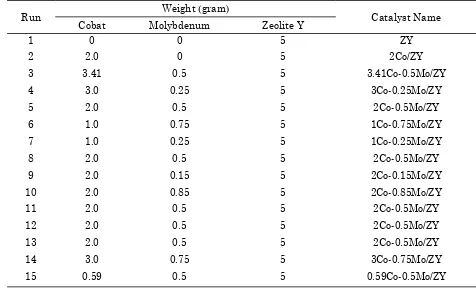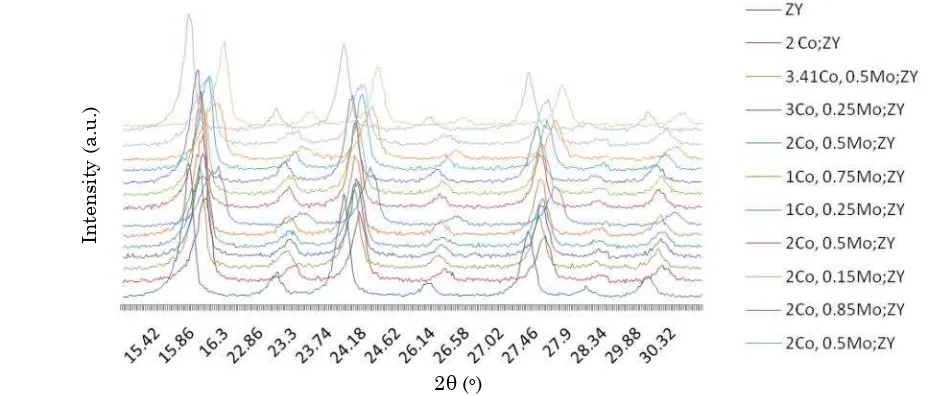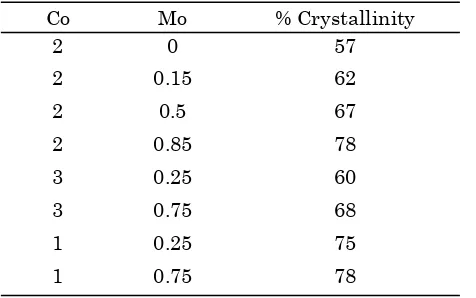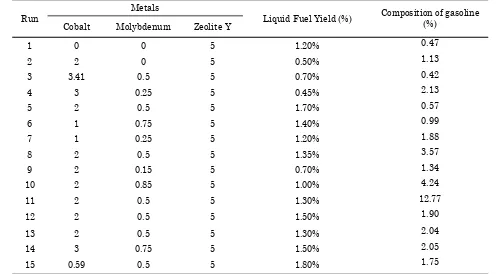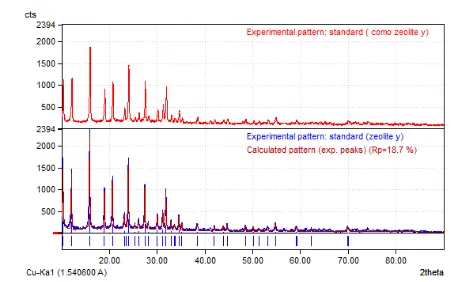Effect of Co and Mo Loading by Impregnation and Ion
Exchange Methods on Morphological Properties of
Zeolite Y Catalyst
Didi Dwi Anggoro1*, Nur Hidayati2, Luqman Buchori1, Yayuk Mundriyastutik1
1Department of Chemical Engineering, Diponegoro University, Jl. Prof. Soedarto, Kampus Undip Tembalang, Semarang 50239, Indonesia
2Department of Chemical Engineering, Universitas Muhammadiyah Surakarta, Jl. A. Yani Pabelan Kartasura, Tromol Pos I, Surakarta 57102, Indonesia
Bulletin of Chemical Reaction Engineering & Catalysis, 11 (1), 2016, 75-83
Abstract
Coal tar can be used as an alternative raw material for the production of liquid fuels, such as: gasoline and diesel through hydrogenation and cracking process. Hydrogenation and cracking process requires a catalyst which has metal components for hydrogenation reaction and acid components for cracking reaction. In this study, the Co/Zeolite Y and Co-Mo/Zeolite Y catalysts were prepared by impregnation and ion exchange methods. Characterizations of the catalysts were carried out by X-Ray Diffraction (XRD) and gravimetric acidity. The catalysts were tested for coal tar conversion to liquid fuel under various temperatures, amount of catalyst and hydrogen flow rates in a fixed bed flow reaction system. Liquid fuels products were analyzed by gas chromatography (GC). The XRD Spectra indicated that the addition of Co and Mo metals did not affect catalysts structure, however it alters the percentage of crystallinity. The addition of Co metal using impregnation method caused reduction in crystallinity, while the addition of Mo caused improvement of crystallinity. The Co-Mo/Zeolite Y catalyst with high-est crystallinity was obtained by loading using ion exchange method. The addition of Co and Mo metals caused increasing acidity. However, the increasing composition of Co and Mo loaded on Zeolite Y cata-lyst decreased the yield of liquid fuels from coal tar. It can be concluded that the yields of liquid fuels and the composition of gasoline fractions from hydrocracking of coal tar were highly dependent on acidity of the catalyst. Copyright © 2016 BCREC GROUP. All rights reserved
Keywords: Coal tar; Cobalt; Molybdenum; Zeolite Y; Morphology
How to Cite: Anggoro, D.D., Hidayati, N., Buchori, L., Mundriyastutik, Y. (2016). Effect of Co and Mo Loading by Impregnation and Ion Exchange Methods on Morphological Properties of Zeolite Y Cata-lyst. Bulletin of Chemical Reaction Engineering & Catalysis, 11 (1): 75-83.
(doi:10.9767/bcrec.11.1.418.75-83)
Permalink/DOI: http://dx.doi.org/10.9767/bcrec.11.1.418.75-83
Available online at BCREC Website: http://bcrec.undip.ac.id
Research Article
1. Introduction
Due to its abundant reserve, coal has re-ceived major attention to replace petroleum as future primary energy source in Indonesia [1]. Coal is a solid fossil fuel containing a variety of
organic and inorganic components. Unfortu-nately, coal liquefaction has a negative effect to the environment due to the production of coal tar as by product. The liquefaction of 1 ton coal may produce 8-12 gallons of coal tar. Coal tar also contains aromatics, such as: benzene, tolu-ene, phenol, and others that can be harmful to humans, fish, and wildlife [2]. Therefore, ef-forts to increase the economic value of coal tar by processing it into more useful materials * Corresponding Author.
E-mail: [email protected] (D.D. Anggoro) Telp./Fax.: +62247460058 / +622476480675
such as fuel are urgently required.
Coal tar is produced from coal gasification process, commonly in the form of carbon dark-viscous liquid of hydrocarbons C7-C20 with mo-lecular weight of 200-1200 [3]. High momo-lecular weight, viscosity and heteroatom compounds (S and N) have classified coal tar as a low quality fuel [4]. Coal tar contains a mixture of ali-phatic, aromatic, alicyclic and heterocyclic com-ponents [2]. Coal tar can be used to produce liq-uid fuels, such as: gasoline and diesel oil, through the process of hydrocracking [5]. With the aim to enhance the hydrocracking ability of the catalysts, more acid supports, such as: zeo-lite and TiO2, have been used [6-11]. Besides, the conventional cracking function of the acidic sites, the catalytic activities for hydrogenation unsaturated compounds and removal of het-eroatoms were also improved with zeolite sup-ports [12-14].
Zeolite is considered as a low cost good cata-lyst, because it has large pores, surfaces area and high acidity. In the petroleum processing industry, zeolite was used as an acid catalyst in cracking [15]. The hydrocracking catalyst must have the ability to with hold from sulfur and nitrogen components contained in coal tar, so that the catalyst can be kept in good condition. Cobalt metal was selected for Zeolite Y catalyst modification due to its high selectivity and
abil-ity to with hold the poison of sulfur and nitro-gen components contained in coal tar. The in-corporation of cobalt metal with zeolite Y and Co-Mo with zeolite Y can be done by method of impregnation or ion exchanges. Emelik et al. [16] and Tsitsihvli [17] have successfully con-ducted catalyst impregnation and ion exchange method for natural zeolite using Ni2+ solution. The results showed that Ni2+ ions were success-fully incorporated into zeolite at concentration of́2.0́Ḿand́temperaturéof́400˚C.
In this study, Co-Mo based zeolite Y cata-lysts were used as a hydrocracking catalyst for coal tar and resulted in light hydrocarbon frac-tion as liquid fuel. The purposes of the research are to analyze the effect of Co and Mo loaded zeolite Y based catalysts on catalyst morphol-ogy prepared by impregnation and ion ex-change over coal tar hydrocracking.
2. Materials and Methods
2.1. Materials
Coal tar was obtained from PT. Sango ce-ramics Indonesia. The metal salts cobalt(II) ni-trate hexahydrate, Co(No)3.6H2O, 99% and am-m o n i u am-m m o l y b d a t e t r a h y d r a t e , (NH4)6Mo7.4H2O, 99% from E. Merck Company. Zeolite Y obtained from Zeolyst International. Hydrogen gas from P.T. Samator, 99.99%,
Bulletin of Chemical Reaction Engineering & Catalysis, 11(1), 2016, 76
Table 1. Catalyst of Co-Mo/Zeolite Y prepared by ion exchange method
Run Weight (gram) Catalyst Name
Cobat Molybdenum Zeolite Y
1 0 0 5 ZY
2 2.0 0 5 2Co/ZY
3 3.41 0.5 5 3.41Co-0.5Mo/ZY
4 3.0 0.25 5 3Co-0.25Mo/ZY
5 2.0 0.5 5 2Co-0.5Mo/ZY
6 1.0 0.75 5 1Co-0.75Mo/ZY
7 1.0 0.25 5 1Co-0.25Mo/ZY
8 2.0 0.5 5 2Co-0.5Mo/ZY
9 2.0 0.15 5 2Co-0.15Mo/ZY
10 2.0 0.85 5 2Co-0.85Mo/ZY
11 2.0 0.5 5 2Co-0.5Mo/ZY
12 2.0 0.5 5 2Co-0.5Mo/ZY
13 2.0 0.5 5 2Co-0.5Mo/ZY
14 3.0 0.75 5 3Co-0.75Mo/ZY
Pyridine 99.5% from E. Merck Company. 2.2. Catalyst preparation by impregnation
Co-Mo/Zeolite Y catalyst was prepared by impregnation method [18] using the following steps: 0.59 gram Co(NO3)2.6H2O and 0.5 gram (NH4)6Mo7O24.4H2O was dissolved in 25 ml aquadest, and followed by addition of 5 grams of́ZeolitéY.́Thémixturéwaśstirred́at́30́˚Ć foŕ 5́ minuteś and́ oveń dried́ at́ 110˚Ć foŕ 24́ hour. The dried mass was finally calcined in a box́furnacéat́temperaturé550́˚Ćfoŕ3́hour.
2.3. Catalyst preparation by ion exchange
The catalysts were prepared using an aque-ous solution of bimetal Co and Mo compounds loaded on zeolite Y by ion exchange methods. The preparation are as follows: Co(No)3.6H2O and(NH4)6Mo7.4H2O dissolved in 25 mL aquadest with addition of 5 grams of zeolite Y, as tabulated on Table 1. The mixture was stirred́ at́ 30́ ˚Ć foŕ 5́ h,́ followed́ bý dryinǵ at́ 110́˚Ćfoŕ24́h.́Finally,́thésolid́werécalcined́ ińábox́furnacéat́temperaturéof́550́˚Ćfoŕ3́ h.
2.4. Characterization and testing catalyst
Crystallinity of the catalyst samples were analyzed by X-Ray Diffraction (XRD) and total acid amount were analyzed by gravimetric us-ing pyridine and ammonia gasses. The catalyst were tested for coal tar conversion to liquid fuel with hydrocracking processes carried out under variable operating conditions of temperature and pressure in a fixed bed tube reactor with 1 inch ID. The activity test were operated using
3.1. Catalyst prepared by impregnation method
3.1.1. Catalyst characterization by X-Ray Dif-fraction (XRD) crystal form in all samples of Zeolite Y catalyst. Base on some literatures, cobalt nitrate hexa-hydrate peaks should appear on 2θ of 15.10o; 15.61o; 27.06o; 28.09o; 30.55o [19]. The percent-age of crystallinity of catalysts is calculated by using Equation 1 using data from X-Ray Dif-fraction [20].
(1) The effect of cobalt loading of Zeolite Y on catalyst crystallinity was tabulated in Table 2. Table 2 showed that more cobalt added to Zeo-lite Y with the same amount of Mo, more the
Bulletin of Chemical Reaction Engineering & Catalysis, 11(1), 2016, 77
hence lowering catalyst crystallinity.
Table 3 shows the effect Mo loaded zeolite Y on catalyst crystallinity. It can be seen that more Mo is added to the catalyst with the same amount of Co, the percentage of crystallinity of the catalyst improved significantly. This may be due to many of Mo metal attached on sur-face of the catalyst, thus forming crystals and increase the percentage of crystallinity.
3.1.2. Characterization of the catalyst acidity using ammonia gas gravimetry
Acidity analysis using gravimetric method employing ammonia gas was used to determine the acidity of a catalyst [21]. Effect of addition of Co on acidity of the catalyst samples is tabu-lated in Table 4. Table 4 shows that the addi-tion of Co on Zeolite Y catalyst at the same amount of Mo increases the catalyst acidity. This may be due to the addition of Co caused the absorption of ammonia gas is increased.
Table 5 is tabulated the effect of Mo loaded
on the catalyst acidity. Table 5 showed that if the addition of Mo on the catalyst is increased with the same amount of Co, it causes increased acidity of the catalyst. This is likely due to the Mo metal increases ammonia gas adsorption. 3.1.3. Testing of catalyst
The reactions mechanism of coal tar hydro-cracking into liquid fuel are illustrated in Fig-ure 2. Yield of liquid fuel depends on the cata-lyst acidity. Results of the catacata-lysts testing un-der different amount of cobalt and molybdenum are tabulated in Table 6. The reaction tempera-turé waś 350́ ˚Ć and́ thé catalyst́ amount́ of́ catalyst is 7 grams, i.e. 5 grams of catalyst which has been prepared (Co-Mo/Zeolite Y) and 2 grams of catalyst ZSM-5. Increasing of X1 (cobalt metal) to produce liquid fuel yield with range of 0.5-1.5% for X2 (molybdenum metal) to produce liquid fuel yield with range of 1-1.5%. The increase in composition of cobalt metal and molybdenum metal leads to increased acid
Bulletin of Chemical Reaction Engineering & Catalysis, 11(1), 2016, 78
Table 3. Effect of Mo on zeolite crystallinity
Co Mo % Crystallinity
Table 4. Effect of Co on catalyst acidity
Mo Co Acidity
Table 5. Effect of metal Mo on catalyst acidity
Co Mo Acidity
Table 2. Effect of Co on zeolite crystallinity
Bulletin of Chemical Reaction Engineering & Catalysis, 11(1), 2016, 79
value, and hence the yield on liquid fuels was de-creased. This is because the effect on the hydro-genation of coal tar cracking on the acid value of the catalyst. The catalyst performance test indi-cated that the yield of liquid fuels decreased as the acid value increased.
3.2. Catalyst prepared using ion ex-change method
3.2.1. Catalyst characterization by X-Ray Dif-fraction (XRD)
Figure 3 indicates that X-ray spectra of Co-Mo/Zeolite Y catalyst has a similar pattern with Zeolite Y but in general show some dif-ferences in intensity at certain 2θ. The differ-ences indicate the amount of loaded metals
Figure 2. The mechanism reactions of hydrocracking coal tar into liquid fuel
Table 6. Testing hydrocracking coal tar when using catalyst by impregnation method
Run
Metals
Liquid Fuel Yield (%) Composition of gasoline (%)
Cobalt Molybdenum Zeolite Y
1 0 0 5 1.20% 0.47
2 2 0 5 0.50% 1.13
3 3.41 0.5 5 0.70% 0.42
4 3 0.25 5 0.45% 2.13
5 2 0.5 5 1.70% 0.57
6 1 0.75 5 1.40% 0.99
7 1 0.25 5 1.20% 1.88
8 2 0.5 5 1.35% 3.57
9 2 0.15 5 0.70% 1.34
10 2 0.85 5 1.00% 4.24
11 2 0.5 5 1.30% 12.77
12 2 0.5 5 1.50% 1.90
13 2 0.5 5 1.30% 2.04
14 3 0.75 5 1.50% 2.05
Bulletin of Chemical Reaction Engineering & Catalysis, 11(1), 2016, 80
[18]. The addition of Co and Mo metals to Zeo-lite Y causes the formation of amorphous struc-ture on the Co-Mo/Zeolite Y.
The XRD spectra of the Zeolite Y and Co-Mo/Zeolite Y catalysts as depicted in Figure 3 show that Co and Mo loaded into Zeolite Y has crystallinity of 84.25%. The loading of metal on Zeolite Y caused reduction in percentage of crystallinity on the catalyst. This is because the metals loading on the catalyst samples cover the surface of catalyst pores, which finally al-tered. Characteristics of the zeolite crystal as indicated by decreasing the intensity may be due to partial loss of structural cations of zeo-lite. However, the peak intensity of Zeolite Y decreases still within the limits of tolerance. 3.2.2. Characterization of the catalyst acidity using gravimetric method
The catalyst acidity test was carried out us-ing gravimetric method with pyridine gas adsorption. Aim of this method is to deter-mine the amount of acid sites on the catalyst. The results of Co-Mo/Zeolite Y concentration is 4.22 mmol/gram pyridine. This result is higher than the amount of acidity of Zeolite Y, i.e. 3.09 mmol/gram pyridine. The increasing catalyst acidity caused the Mo metal loading into zeo-lites pore has 6 unpaired electrons in d orbitals
than loading Co metal having 3 unpaired elec-trons in d orbital. The metals transition hav-ing full d orbitals are not effective as electron - pair acceptors of adsorbate. As contributor of Lewis acid sites is able to increase the acid-ity of catalyst [22].
3.2.3. Testing of catalyst
Testing of catalyst for hydrocracking proc-ess of coal tar using Co and Mo loaded Zeolie Y catalysts were conducted by 16 experimen-tal runs (Table 7), which used the response surface methodology by 3 factorials 4 star points, and 4 center points. The products of hydrocracking coal tar were hydrocarbons of C6-C11 or gasoline ranges. The chromatogram shows that the retention time of the com-pounds ranges from 1.8-18.50 similar to the standard gasoline C6-C11.
Table 7 indicated that the yield of liquid fuels using Co-Mo/Zeolite Y catalyst is higher (1.9%) than using Zeolite Y catalyst (1.0%). This is due to that the acidity of Co-Mo/Zeolite Y catalyst is higher (3.88) than Zeolite Y cata-lyst (3.58). According to Wega et al. [21] stated the catalyst performance test and indicated that the yield of liquid fuels increased as the acid value increased.
Bulletin of Chemical Reaction Engineering & Catalysis, 11(1), 2016, 81
3.3. Comparison of effect of Co and Mo loaded Zeolite Y on catalyst morphology by impregnation and ion exchange meth-ods
3.3.1. Catalyst characterization by X-Ray Dif-fraction (XRD)
The catalyst crystallinity of 0.59 g Co and 0.5 g Mo loaded Zeolite Y on catalyst morphol-ogy by impregnation and ion exchange methods from XRD analysis are 83% and 84%, respec-tively. Higher catalyst crystallinity can be achieved by ion exchange method rather than impregnation method. This is because reduc-tion of surface area of the metal loaded Co-Mo Zeolite Y indicates a strong interaction between the surface zeolite Y and Co and Mo [22] ena-bling good dispersion of the metals on the sur-face.
3.3.2. Characterization of the catalyst acidity using ammonia and pyridine gases gravimetric method
The acidity of catalyst using 0.59 g Co and 0.5 g Mo loaded Zeolite Y by impregnation method is higher than by ion exchange method. Comparing catalyst acidity using ammonia gas gravimetric of 0.59 Co - 0.5 Mo/Zeolite Y cata-lyst using impregnation method obtained 9.19
mmol/gram, as well as by ion exchange was obtained of 4.22 mmol/gram. The amount of acid sites indicated by ammonia adsorption is greater than the vapor of pyridine because it has stronger base than pyridine. The size of molecules contained ammonia relative smaller than pyridine so it is easier adsorp to the sur-face of the pore than pyridine only adsorb to the pore surface [23].
3.3.3. Coal tar hydrocracking to liquid fuel The coal tar hydrocracking reaction was done using 5 grams of catalyst which was pre-pared (Co-Mo/Zeolite Y) and 2 grams of cata-lyst ZSM-5 at 350 oC with a flow rate of 5 mL/min. The yield of liquid fuels using 0.59 g Co and 0.5 g Mo loaded zeolite Y catalyst us-ing impregnation method was 1.8%, while its gasoline composition was 1.75%. The 0.59Co-0.5Mo/Zeolite Y catalyst of ion exchange method for hydrocracking of coal tar carried by using independent variable amount of cata-lyst, reaction temperature and hydrogen flow rate obtained optimum yield of 1.42% and gasoline composition 7.27%.
A comparison of performance testing of catalyst obtained by impregnation method and ion exchange methods showed that the yields of liquid fuels using impregnation
Table 7. Testing hydrocracking coal tar using catalyst by ion exchange method
Run
Bulletin of Chemical Reaction Engineering & Catalysis, 11(1), 2016, 82
method is higher than the ion exchange method. However, catalyst obtained by ion ex-change method results in higher composition of gasoline fractions. This indicates that a process of reaction formation via carbocation, where each ion carbonium production will induce other compounds to form new carbonium ion with a smaller number of atoms, with the addi-tion of metallic Co and Mo can improve high ac-tivity in the hydrocracking of coal tar. It is evi-dent from the high results of the composition of the product. In addition to the greater composi-tion of metals, cobalt and molybdenum metals also affect the process of hydrogenation of coal tar cracking in the power value of the acid cata-lyst. Lin et al. [24] showed that the activation energy of a reaction will decrease drastically with increasing acid strength of a catalyst, es-pecially in the process that has a lot of reaction. 4. Conclusions
Loading of Co and Mo on Zeolite Y catalyst prepared by using impregnation and ion ex-change method did not ex-change the structure of catalysts. The percentage of catalyst crystallin-ity for catalyst prepared by ion exchange method was high, while acidity of the catalyst was high for the catalyst prepared by using pregnation. The yields of liquid fuels using im-pregnation method was greater than using ion exchange method, however composition of frac-tions gasoline greater if using ion exchange method. These results can be concluded that the yields of liquid fuels and the composition of fraction gasoline from hydrocracking of coal tar depend on the acidity of catalyst. If the acidity of catalyst was high, the yield of liquid fuels was increased, however the composition of gasoline fraction was decreased.
Acknowledgments
The authors gratefully acknowledge the fi-nancial support from Diponegoro University DIPA Number 214-05/UN7.5.1/PG / 2015 and 15, 2013, from http://www.esdm.go.id/ stat i s stat i k / d a stat a s e k stat o r e s d m / c a stat _ v i e w / 5 8 - publikasi/240-statistik/341-statistik-minyak-bumi.html.
[2] Kan, T., Wang, H., He, H., Li, C., Zhang, S., (2011) Experimental Study on Two-stage catalytic hydroprocessing of middle
-temperature Coal tar to clean liquid fuels, Fuel, 90: 3404-3409.
[3] Rokhati, N. (1999). Pirolisis Tir Batu Bara Secara Sinambung, Master Thesis. Univer-sitas Gajah Mada (in Indonesian)
[4] Krichko, A.A., Maloletnev, A.S., Mazneva, O., Gagarin, S.G (1996). Catalytic Properties of High-Silica Zeolite in Hydrotreatment of Coal Liquefaction Product, Fuel, 76: 683-685.
[5] Fanani, Z. (2010). Hidrocrakcing Tir Ba-tubara Menggunakan Katalis Ni-Mo-S/ZAA untuk Menghasilkan Fraksi Bensin dan Fraksi Kerosen, Jurnal Penelitian Sains, 1006, (08) 22-33
[6] Sayan, S, Paul, J. (2002) Hydrogenation of naphthalene and methylnaphthalene: Mod-eling and spectroscopy. J. Molec. Catal. A:
Chem., 185: 211–222.
[7] Ramirez, J., Rayo, P., GutiRrez-Alejandre, A., Ancheyta, J., Rana, M.S. (2005) Analysis of the hydrotreatment of Maya heavy crude with NiMo catalysts supported on TiO2
-Al2O3 binary oxides: Effect of the
incorpora-tion method of Ti. Catal. Today, 109: 54-60.
[8] Wang, L., Shen, B., Fang, F., Wang, F., Tian, R., Zhang, Z., Cui, L. (2010) Upgrading of light cycle oil via coupled hydrogenation and ring-opening over NiW/Al2O3-USY
cata-lysts. Catal. Todaý158:́343-347.
[9] Arribas,́M.A.,́Martı́nez, A. (2002) The influ-ence of zeolite acidity for the coupled hydro-genation and ring opening of 1-methylnaphthalene on Pt/USY catalysts.
Appl. Catal. A: Gen., 230: 203-217.
[10] Leite, L., Benazzi, E., Marchal-George, N. (2001) Hydrocracking of phenanthrene over bifunctional Pt catalysts. Catal. Today, 65: 241-247.
[11] Hassan, A., Ahmed, S., Ali, M.A., Hamid, H., Inui, T. (2001) A comparison between [beta]- and USY-zeolite-based hydrocracking cata-lysts. Appl. Catal. A: Gen., 220: 59-68.
[12] Gallezot, P. (1979) The state and catalytic properties of platinum and palladium in fau-jasite-type zeolites. Catal. Rev. Sci. Eng. 20: 121–154.
[13] Zheng, J., Guo, M., Song, C. (2008) Charac-terization of Pd catalysts supported on USY zeolites with different SiO2/Al2O3 ratios for
the hydrogenation of naphthalene in the presence of benzothiophene. Fuel Process.
Technol., 89: 467-474.
Bulletin of Chemical Reaction Engineering & Catalysis, 11(1), 2016, 83
[15] Chorkendorff, Niemantsverdriet, (2003) Con-cepts of Modern Catalyst and Kinetics, WILEY-VSH Verlag GmbH & Co. KGaA, Weinheim.
[16] Emelik, B., (1980) Catalysis by Zeolite, Pro-ceeding of an International Symposium, El-sevier Scientific, Publishing Co, New York.
[17] Tsitsishvili, G.V. (1992) Natural Zeolites, Ellis Horwood. New York,16-19.
[18] Zeno, R.R., Tria, F. (2015), Effect of Co and Mo Metal Addition in Co-Mo/Zeolite Y Cata-lyst for Coal Tar Conversion To Liquid Fuel,
Undergraduate Thesis, Chemical
Engineer-ing, Diponegoro University.
[19] Li, L., Quan, K., Xu, J., Liu, F., Liu, S., Yu, S., Xie, C., Zhang, B., Ge, X. (2014) Liquid hydro-carbon fuels from catalytic cracking of rubber seed oil using USY as catalyst, Fuel, 123: 189-193.
[20] Nicolaides, C.P. (1999). A novel family of solid acid catalysts: substantially amorphous or-partially crystalline zeolitic materials,
Ap-plied Catalysis A: General 185: 211-217.
[21] Trisunaryanti, W. (2002) Optimation of Time and Catalyst/Feed Ratio in Catalytic Cracking of Waste Plastics Fraction to Gaso-line Fraction Using Cr/Natural Zeolite Cata-lyst, Indonesian Journal of Chemistry, 2: 30-40.
[22] Anggoro, D.D, Amin, N.A.S. (2006) Methane to Liquid Hydrocarbons over Tungsten-ZSM-5 and Tungsten Loaded Cu/ZSM-Tungsten-ZSM-5 Cata-lysts, Journal of Natural Gas Chemistry 15: 340-347.
[23] Trisunaryanti, W., Purwono, S., Putra, A. (2008) Catalytic Hydrocracking of Waste Lu-bricant Oil Into Liquid Fuel Fraction Using ZnO, Nb2O5, Activated Natural Zeolite Their
Modification, Indo. J. Chem., 342-347.
[24] Lin, L., Qiu, C., Zhuo, Z., Zhang, D., Zhao, S., Wu, H., Liu, Y., He, M. (2014) Acid Strength Controlled Reaction Pathways for the Catalytic Cracking of 1-Butene to Pro-pene over ZSM-5, Journal of Catalysis, 309: 136-145.
Selected and Revised Papers from The 2nd International Conference on Chemical and Material Engineering 2015
(ICCME 2015) (29-20 September, 2015, Semarang, Indonesia)
